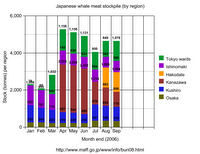David @ Tokyo
Perspective from Japan on whaling and whale meat, a spot of gourmet news, and monthly updates of whale meat stockpile statistics11/16/2006
Japan's whale meat stockpiles (by region)
The official frozen marine product stock figures that I have been graphing lately have included data about the top stockpile locations since January this year (unfortunately not prior to that).
So let's take a look at another graph:
 This graph shows the level of stocks in frozen storage at the month end per region.
This graph shows the level of stocks in frozen storage at the month end per region.Kanazawa, a port city on the Sea of Japan coast, suddenly starts to feature as of the April month-end figures. The reason for this is because no figures were available for Kanazawa for the previous 3 months of the year (presumably because Kanazawa wasn't in the top 7 then). The sudden huge influx of whale meat stock was due to the return of the JARPA II fleet from the Antarctic, which returned back to Japan arriving at Kanazawa.
It appears that the other smaller chunk of the JARPA II by-product whale meat that hit the stockpile figures in March found it's way into Tokyo warehouses, which were previously almost empty, at just around 80 tonnes.
For Hakodate (which only appears in the most recent figures, since August month-end and September) the story is probably similar to Kanazawa. The JARPN II research appears to have used Hakodate as a base, resulting in the sudden jump from nowhere to more than 1,000 tonnes at the end of August. Kushiro (in July) also appears to be the location for another portion of the JARPN II by-products.
Meanwhile, the major consumer markets of Tokyo and Osaka appear to have seen an influx of stocks from Kanazawa during July, coinciding with the sale of JARPA II by-products that was held from July 3rd to August 3rd (from this ICR press release).
Note that the sale of the 1,897.8 tonnes JARPN II products is scheduled for between November 29 and January 9 '07 (as seen in this other ICR press release), so the level of stocks in Hakodate, Ishinomaki and Kushiro, where this meat appears to be located, should remain at fairly high levels until the December month end.
The official figures only provide the top 7 regions per month, and the graphing tool I'm using only allows me up to 6 lines, so I've not included all the figures available. For the record, Yokohama, Shimonoseki and Nagasaki were the other 3 locations that made it into the top 7 in any of the 9 months for which figures are available. In brief:
- Nagasaki's stockpile was well less than 100 tonnes each month
- Shimonoseki's stockpile was roughly around 100 tonnes each month
- Yokohama's stockpile was quite high January month-end at 404 tonnes, but steadily decreased month by month and dropped out of the top 7 by August month-end
 From this it appears that the top 7 stockpile regions account for between 85% and 90% of all frozen stocks indicated in the official figures.
From this it appears that the top 7 stockpile regions account for between 85% and 90% of all frozen stocks indicated in the official figures.An interesting feature is that, with the exception of Tokyo in January and February, stockpile levels in Tokyo and Osaka are reasonably stable, unlike Ishinomaki and Kushiro, which exhibit a fairly consistant decreasing trend for the first several months of the year.
With little incoming stock scheduled before the approximately 3,500 tonnes of JARPA II meat likely to arrive in March and April 2007, it will be interesting to watch how the various stockpiles decrease over the coming months, particularly with regard to Tokyo and Kanazawa, which I assume will be recipient to the by-products again next year.
As an aside, AFP apparently reported that
"Whale meat consumption in Japan dropped sharply after the commercial moratorium but has since been growing"This is first time in a long while that a western media source has made a statement that actually reconciles with official stockpile figures. Well done AFP.
Labels: stockpile figures, Whaling
私のBlog へのコメント書き込み、ありがとうございました。遊びに来ましたのでコメントを残していきます。
・・・自分の浅はかな知識が恥ずかしくなりますね。通訳の2次試験でこのトピックが取り上げられたことがありましたのでその対策、ということで浅はかな知識でスクリプトを作ったのですが、Davidさんの記事を見て赤面です。
これからもちょくちょくよらせていただきます。
<< Home
Archives
June 2004 July 2004 August 2004 September 2004 October 2004 November 2004 December 2004 January 2005 March 2005 April 2005 May 2005 June 2005 July 2005 August 2005 September 2005 October 2005 November 2005 December 2005 January 2006 February 2006 March 2006 April 2006 May 2006 June 2006 July 2006 August 2006 September 2006 October 2006 November 2006 December 2006 January 2007 February 2007 March 2007 April 2007 May 2007 June 2007 July 2007 August 2007 September 2007 October 2007 November 2007 December 2007 January 2008 February 2008 April 2008 May 2008 June 2008 July 2008 August 2008 September 2008 October 2008 November 2008 December 2008 January 2009 February 2009 March 2009 April 2009 May 2009 June 2009 July 2009 August 2009 September 2009 October 2009 November 2009 January 2010 February 2010 April 2010 May 2010 June 2010 July 2010 August 2010 September 2010 February 2011 March 2011 May 2013 June 2013

